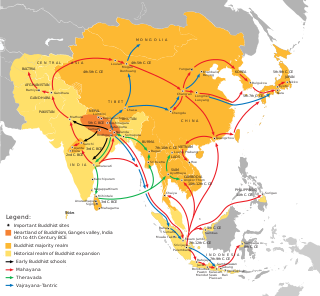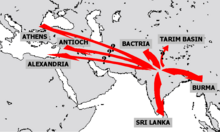History of Buddhism

The history of Buddhism reaches from the 6th century BC. Until the present. Starting with the birth of Siddharta Gautama in Lumbini in present-day Nepal , Buddhism is one of the oldest practiced religions. From the northeast of the Indian subcontinent , Buddhism spread to Central , East and Southeast Asia . Its development includes numerous movements, divisions and schools, especially the Theravada , Mahayana and Vajrayana traditions .
Siddharta Gautama

The dates of Siddharta Gautama's life are traditionally dated 563–483 BC. Chr. Indicated. As things stand today, the dates of death vary between 420 and 368 BC. According to tradition, he was born in Lumbini in what was then the principality of Kapilavastu , today's Nepal , as the son of the ruling house of Shakya and grew up in a wealthy family. Hence its name Shakyamuni (sage from the house of Shakya).
He was married at the age of 16 and his son was born 13 years later. At the age of 29, Siddharta realized that suffering such as aging, illness, death and pain are inseparable from life and that his worldly knowledge and wealth can do nothing to alleviate it. Seven years of asceticism , study and then meditation finally led him to the path of the center , where he was able to develop his inner potential through meditation. Under a poplar fig, the bodhi tree (tree of enlightenment) in what is now northern India, he had the experience of awakening ( bodhi ) and achieved enlightenment. A little later he gave his first discourse in today's Sarnath , with which he laid the foundation stone of the Dharmachakra .
He then spent the rest of his life as a Buddha teaching and transmitting Buddhist teachings . Its quadruple community consisted of monks and nuns , Buddhist monasticism, and lay men and women .
Buddha died at the age of about 80 in Kusinara in a grove of blossoming trees. The Buddhist calendar begins with his death .
Early history
According to legend, shortly before his death, Buddha Shakyamuni gathered his monks around him and silently twirled a lotus flower between his fingers. All the monks were at a loss, except for Mahakashyapa , who smiled and understood everything without a word. This set the wheel of teaching ( Dharma ) in motion and Mahakashyapa became the first Buddhist patriarch . This process is of great importance in later Zen Buddhism . Since the essence of the teaching was not available in writing, from then on it was always passed on from teacher to student.
Three months after the Buddha's death, his disciples met in Rajagarha for the first Buddhist council (sangiti) to discuss the Dhamma (the doctrine) and the Vinaya (the monastic rules) and to record them according to the Buddha's teachings. At the second council, about 100 years later, the Buddhist order split into two main directions, from which Hinayana and Mahayana Buddhism later developed. Hinayana means the small vehicle and Mahayana means the large vehicle . The Mahayana followers were of the opinion that their goals were greater than those of the Hinayana followers, the ancient school of wisdom. In Hinayana, the practitioner personally wishes to be liberated from all suffering. The teaching of Hinayana that still remains today is Theravada Buddhism (teaching of the ancients).
During the reign of Emperor Ashoka (268–232 BC) Buddhism spread across India and far beyond. The third Buddhist council also took place at this time. Ashoka led his country to cultural prosperity through the realization of Buddhist principles through non-violence and peace. He had monasteries and other buildings built and sent monks in all directions. In Ceylon , texts of Theravada Buddhism were written on palm leaves in the 1st century BC . As a result, the teaching spread to the neighboring countries of Myanmar , Cambodia , Laos and Thailand .
In India, Buddhism was partly merged with the older Hindu ideas. Buddhism was thus robbed of its spiritual centers in its country of origin. Today less than 1% of the Indian population is Buddhist.
Zen Buddhism
The Indian monk Bodhidharma (* around 440 ; † around 528 ) is considered the founder of Chan Buddhism . He is the 28th successor of the Buddha. Various forms of Buddhism reached Japan via Korea and China around 1200, where the word Chan Buddhism was transformed into the more common variant Zen Buddhism. The school of Zen Buddhism achieved great importance. In addition to physical work and common recitation , the focus in Zen Buddhism is primarily on meditation and the resulting concentration.
An important practice of Zen is to sit for a long time with your legs crossed, known as zazen . Furthermore, meditative acts in Zen are carried out in very different activities, such as B. Sadō (or Chadō) - the way of the tea ceremony (Teeweg), Shodō - the way of writing, Kadō (also: Ikebana) - the way of the flower arrangement, Suizen - the artful play of the Shakuhachi bamboo flute, Zen garden - the art of Garden design, Kyūdō - the art of archery or Budō - the way of war.
1st to 10th century AD
The teaching of Mahayana spread in eastern India to Southeast Asia and northwards to China and Korea. Eventually the Mahayana came to Japan in the 6th century and Tibet in the 7th century .
After the end of the Cushan Empire, Buddhism flourished in India during the Gupta Empire (4th – 6th centuries). Mahayana schools were built, especially in northeastern India, where large and influential Buddhist schools arose for many centuries. The influence of the Gupta style shaped Buddhist art. Xuanzang reported in his travels through India in the 7th century that the greatest expansion of Buddhism can be seen in the present-day states of Andhra Pradesh and Tamil Nadu . In the 10th century, Buddhism suffered a sharp decline in India.
From the 11th century AD

From the 11th century onwards, the destruction of Buddhism in mainland India brought about the decline of the Mahayana. King Anawrahta (1044-1078), the founder of the Bagan Kingdom , accepted the Theravada Buddhist faith in his country and founded numerous temples between the 11th and 13th centuries. Today the remains of over 3,000 structures are still preserved in the area around Bagan. Though the rise of Thai caused a sensation in Burma, Theravada Buddhism is the most widespread belief in Myanmar. During the Ayutthaya period (14th to 18th centuries) Theravada Buddhism was also strengthened in Thailand, where it is now an integral part of Thai society. Theravada Buddhism spread to Laos and Cambodia in the 13th century. From the 14th century onwards, Islam grew stronger and Malaysia, Indonesia and the southern part of the Philippines adopted it instead of Buddhism. Suharto's rise to power in 1966 resulted in a remarkable renaissance of Buddhism in Indonesia. So Buddhism was incorporated into one of the five official Indonesian religions. There are about ten million Buddhist people in Indonesia today, a large majority of whom are of Chinese descent.
Since the 19th and especially since the 20th century, there has also been a growing tendency towards Buddhism in the industrialized countries of Europe, the USA and Australia. Organizations like the EBU ( European Buddhist Union ) founded in 1975 have set themselves the goal of networking these groups with one another and involving them in a discourse . In many European countries, Buddhism was publicly and state recognized as a religion towards the end of the 20th century, but not in Germany and Switzerland.
Today there are around 250 to 500 million Buddhist devotees worldwide. There are around 250,000 of them in Germany.
literature
- Jens-Uwe Hartmann : The spread of Indian Buddhism to Afghanistan and Central Asia. P. 412–439, special print from: Heinz Bechert (Hrsg.): Der Buddhismus I. Indian Buddhism and its ramifications. W. Kohlhammer, Stuttgart 2000 ( online )
Individual evidence
- ^ Heinz Bechert : The Date of the Buddha Reconsidered . In: Indologica Taurinensia 10, 1982, pp. 29-36 and the like: The lifetime of the Buddha - the oldest fixed date in Indian history? In: News of the Academy of Sciences in Göttingen, Philological-Historical Class, No. 4, 1986
- ↑ Helwig Schmidt-Glintzer : The Buddhism . CH Beck, Munich 2005, p. 42
- ↑ History of Buddhism, Shaolin Temple Germany, section Buddha's successors and the spread of the teachings
- ↑ Census of India 2001: Population by religious communities.
- ↑ 3sat: Brief History of Buddhism
- ↑ Personality of Xuanzang Sanzang ( Memento from March 24, 2007 in the Internet Archive )
- ↑ Buddhism In Andhra Pradesh ( Memento from May 18, 2011 in the Internet Archive )
- ^ Encyclopædia Britannica 2005.
- ^ Todd M. Johnson, Brian J. Grim, The World's Religions in Figures: An Introduction to International Religious Demography.

